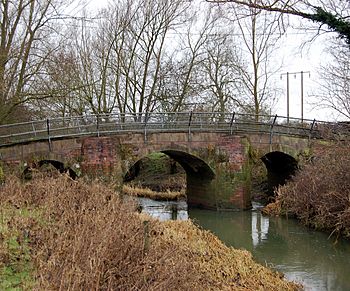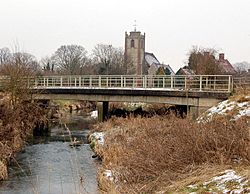River Itchen, Warwickshire facts for kids
Quick facts for kids Itchen |
|
|---|---|

Bridge carrying a minor road over the River Itchen near Long Itchington
|
|
|
Location of the mouth within Warwickshire
|
|
| Country | England |
| Region | Warwickshire |
| Physical characteristics | |
| Main source | Wormleighton 52°11′02″N 1°20′50″W / 52.1839°N 1.34724°W 150 m (490 ft) |
| River mouth | River Leam 63 m (207 ft) 52°19′05″N 1°24′24″W / 52.31797°N 1.4066°W |
| Length | 28.7 km (17.8 mi) |
The River Itchen is a small river in Warwickshire, England. It is about 29 kilometers (18 miles) long. The river generally flows from the south towards the north. It is an important part of the local landscape and history.
River Itchen's Journey
The River Itchen starts its journey near a place called Wormleighton. It flows into a wide valley. This valley is next to some ironstone hills. These hills are on the border of Warwickshire and Northamptonshire. Soon after it begins, the river goes under the Oxford Canal.
As the river grows, it gets water from several small brooks. It then flows past the village of Bishop's Itchington. This village is actually named after the river! The river also goes under an old railway line. This line used to connect London to Birmingham.
About 2.4 kilometers (1.5 miles) north of Bishop's Itchington, the River Itchen passes under Deppers Bridge. This bridge gives its name to a nearby small village. Another 1.6 kilometers (1 mile) further, it flows under the A425 main road. This is just west of the town of Southam.
Right after this bridge, the river flows through Stoneythorpe Park. It also passes a small village called Bascote. About 1.6 kilometers (1 mile) north of Bascote, the Grand Union Canal crosses the Itchen valley. It does this on a long raised bank of earth. The canal is carried over the river on a special bridge called an aqueduct.
The River Itchen then reaches the big village of Long Itchington. This village is also named after the river. The river flows very close to the village church. West of the village, the river briefly turns west. Its winding path is crossed twice by an old railway line. This old line is now a path for walking and cycling.
Finally, the River Itchen turns north again. About 5 kilometers (3 miles) further on, it reaches Marton. Here, the River Itchen flows into the River Leam.
River Itchen's Past
The name of the River Itchen is very old. It comes from a language that was spoken before the Celts arrived. We don't know exactly what the name means. But we do know it gave its name to the villages of Bishop's Itchington and Long Itchington. These villages are found along its path.
In 2009, a sad event happened. Many fish in the River Itchen died. This was because of something that washed off nearby farmland. Later that year, people helped the river recover. They released 3,500 new fish into the water. These included roach, dace, and chub. This helped to bring the fish numbers back up.
A part of the River Itchen is a special protected area. It is called a Site of Special Scientific Interest. This means it's important for nature and science. Scientists have studied this part of the river. It has helped them learn how rivers change over time. They learned how river activity is linked to changes in climate.
River Itchen's Water Quality
The Environment Agency checks the water quality of rivers in England. They give each river system an overall "ecological status." This status can be high, good, moderate, poor, or bad. They look at different things to decide this.
- Biological status: This checks the types and amounts of living things in the water. It includes tiny invertebrates, flowering plants, and fish.
- Chemical status: This checks the levels of different chemicals in the water. They compare these levels to safe amounts. The chemical status is either "good" or "fail."
In 2019, the water quality of the River Itchen was checked. The river's ecological status was "moderate." This means it was not perfect, but not terrible either. However, its chemical status was "fail." This shows that there were some chemical issues in the water.



